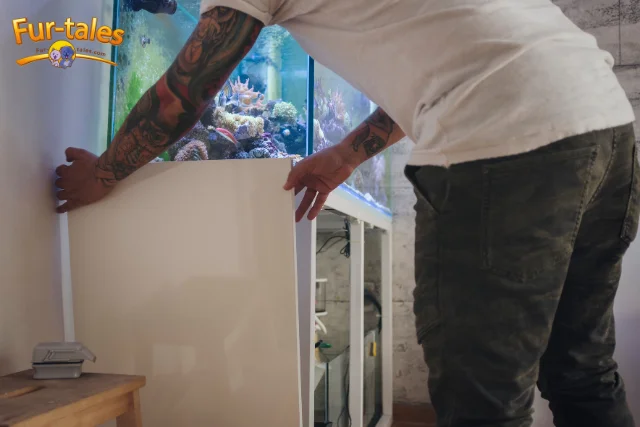
Avoid Costly Mistakes: 8 Pro Tips for Saltwater Fish Tank Maintenance
Saltwater aquariums glow with neon corals, shimmering tangs, and the quiet hum of reef life—but behind that beauty lies steady, strategic Fish Tank Maintenance. Whether you keep a 20-gallon nano reef or a six-foot show tank, regular care keeps water chemistry stable, livestock healthy, and long-term costs low. Follow these eight budget-friendly, professional tips and transform routine chores into confident habits.
1 Get to Know Your Water Parameters First
Successful marine keeping begins with understanding salinity, temperature, pH, alkalinity, calcium, magnesium, ammonia, nitrite, and nitrate. Write target ranges on a laminated card and tape it inside the stand door. Use a refractometer (not a cheap hydrometer) and a digital thermometer with an alarm. By logging weekly readings, you’ll spot creeping changes before they threaten fish or corals. Consistent documentation lays the foundation for every other aspect of Fish Tank Maintenance.
2 Mix and Age Your Own Saltwater Correctly
Pre-mixed saltwater from a store is easy but pricey and prone to parameter drift. Invest once in a food-grade barrel with a small circulation pump. Add RO/DI water, then marine salt, letting it mix for 24 hours. Heating the barrel to tank temperature prevents shock during water changes. Label the barrel’s salinity goal (usually 35 ppt) and mark gallons on the side so you can repeat batches precisely—crucial when Fish Tank Maintenance schedules call for 10–15 percent weekly swaps.
3 Adopt a Consistent Testing Schedule
Most tank crashes are slow boils, not sudden explosions. Set phone reminders: basic parameters every Sunday, calcium/alkalinity/magnesium every other Wednesday, and phosphate once a month. Use reliable test kits or send mail-in ICP analyses quarterly. Regular data prevents over-corrections that swing chemistry. Think of testing as the smoke alarm of Fish Tank Maintenance: you may not hear danger until it’s too late, unless you monitor continuously.
4 Optimize Filtration and Protein Skimming
Mechanical, biological, and chemical filtration work together. Rinse mechanical filter socks twice weekly to remove detritus before it breaks down. Clean skimmer necks every three days—foam rises faster in a slick column, pulling dissolved organics out. Swap activated carbon monthly to polish water and reduce odor. A well-tuned skimmer can remove up to 60 percent of organic waste, slashing the workload for the rest of your Fish Tank Maintenance routine.
5 Balance Lighting and Control Algae
LED fixtures deliver reef-safe spectra yet can fuel nuisance algae if left unchecked. Program a ramp: eight hours of peak daylight and a dim lunar phase overnight. Use a light meter app to ensure PAR levels meet coral needs without blasting excess photons onto rock. Scrape glass three times a week with a magnetic cleaner and deploy a cleanup crew of snails, hermits, and emerald crabs. Lighting discipline keeps your display pristine and reduces elbow grease in broader Fish Tank Maintenance efforts.
6 Feed Responsibly to Prevent Nutrient Spikes
Marine fish beg like teenagers, but overfeeding dumps phosphate and nitrate into the water column. Thaw frozen foods in RO water, strain, and target-feed with a turkey baster. Rotate pellets, flakes, and live foods to meet varied nutritional needs without bloating fish. Observe each meal; anything uneaten after five minutes gets siphoned out. Precise feeding keeps biological filters from overload and lightens the bio-load managed by Fish Tank Maintenance tasks.
7 Schedule Regular Partial Water Changes
No filter substitutes for fresh seawater. Change 10 percent weekly or 20 percent bi-weekly, depending on stocking density. Turn off heaters and pumps, siphon detritus from the sump, and stir stubborn mulm with a turkey baster before removal. Replace with aged, temperature-matched saltwater. Water swaps reset trace elements, export nitrates, and provide the single biggest bang for your Fish Tank Maintenance buck.
8 Quarantine New Additions and Prevent Disease
A $40 hospital tank can save thousands in livestock. Quarantine fish for 30 days, treating prophylactically for ich and flukes, and isolate corals to dip away pests like flatworms or nudibranchs. Observe eating habits and waste output. Introducing only healthy specimens keeps the main display disease-free, sparing time and money otherwise lost to emergency Fish Tank Maintenance measures.
Frequently Asked Questions
Q 1: How often should I replace filter media?
Mechanical socks need rinsing twice a week and full replacement every three months. Activated carbon swaps monthly, while biological media like ceramic rings last years unless clogged.
Q 2: Can I use tap water with conditioner?
Conditioners remove chlorine but not silicates and heavy metals. RO/DI systems are safer long-term and reduce algae, making overall Fish Tank Maintenance easier.
Q 3: What’s the ideal temperature range for most saltwater tanks?
Between 76 °F and 78 °F. Stability matters more than hitting an exact number; use dual heaters and a controller for redundancy.
Q 4: Why does my skimmer overflow after water changes?
Fresh salt mixes temporarily alter surface tension. Lower the skimmer’s water level beforehand and resume normal settings after two hours.
Q 5: Do I need an automatic top-off (ATO) system?
Yes. ATO units replace evaporated water with RO/DI, preventing salinity swings and reducing daily manual labor in Fish Tank Maintenance.
Image Source: Canva
